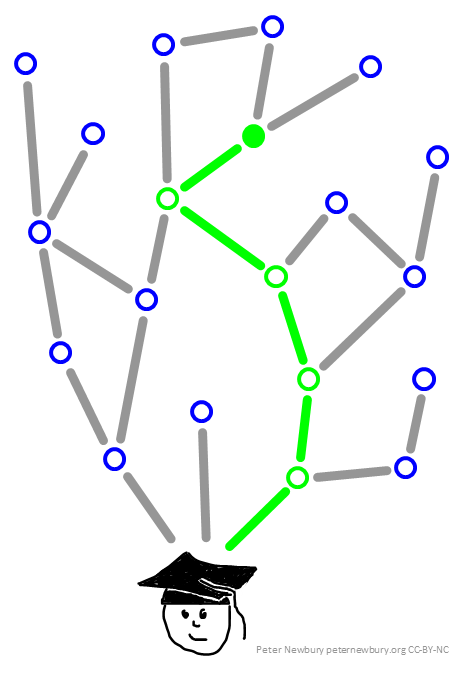No matter what course you teach, one of your course-level learning outcomes should be that students will think more like experts in your field. They won’t be experts yet, not after one course or even an undergraduate degree, but they can think in more expert-like ways.
How do experts think?
According to How People Learn, experts must
- have a deep foundation of factual knowledge
- understand those facts and concepts in a conceptual framework
- organize the knowledge in ways that facilitate retrieval and application
Here’s how I picture that conceptual framework:
It’s not enough just to teach the factual knowledge: you also have to help students build the conceptual framework and give them practice retrieving and applying the facts and concepts:
(My thanks to Kimberly Tanner at San Francisco State University for reminding me that anyone can memorize a bunch of facts; expertise lies in the conceptual framework and retrieval.)
What does your classroom look like?
Yes, let’s support expert-like thinking and behavior. But how do you do it? I think Ken Bain, in What the best college teachers do (2004), describes it perfectly:
More than anything else, the best teachers try to create a natural critical learning environment: natural because students encounter skills, habits, attitudes, and information they are trying to learn embedded in questions and tasks they find fascinating—authentic tasks that arouse curiosity and become intrinsically interesting; critical because students learn to think critically, to reason from evidence, to examine the quality of their reasoning using a variety of intellectual standards, to make improvements while thinking, and to ask probing and insightful questions about the thinking of other people.
The big idea, then, is to pick instructional strategies that give students practice thinking like experts, in a natural and authentic way.
The Slippery Slope to Peer Instruction
My colleague Beth Simon and I have come up with a strategy we call, “The Slippery Slope to Peer Instruction.”
2-minute pause: The 2-minute pause procedure is really easy to implement in a class because you literally don’t do anything. Every 15 or 20 minutes of lecture, when you sense your students’ brains are full, you stop lecturing and invite the students to take 2 minutes to
-
review their notes
-
consult with neighbors to fill in missing points
-
check with neighbors if anything is confusing
-
formulate a question(s) that will clear up confusion or fill in a gap (this is very expert-like behavior!)
When conversations dies down (wait longer than 2 minutes if there’s good stuff happening) lead a brief, class-wide discussion to answer questions and resolve confusion. They’ll probably have questions you haven’t thought about (because if you did think about them, you’d have covered it in the lecture.) Answer by “thinking-aloud”, that is, sharing aloud that voice in your head as you figure it out. When everyone is back up-up-to-speed and has had a chance to hang some knowledge on their conceptual framework, you can pick up where you left off.
2-minute pause Pro™: Maybe when you pause, your students
- aren’t confused
- don’t have anything to talk about
- don’t know how to have expert-like conversions
Then “seed” the pause with a question. You could get them to reconsider what you’ve just covered:
Okay, everyone, that’s a lot to think about. Take 2 minutes to look over your notes. If you’re confused about something, check with your neighbors. If everything’s okay, think about this: what do you suppose would happen if they run that experiment with adults instead of children?
Or prime them for what’s coming:
Okay, everyone, that’s a lot to think about. Take 2 minutes to look over your notes. If you’re confused about something, check with your neighbors. If everything’s okay, think about this: How do you think this result will change when we apply it in 3 dimensions instead of 2?
Peer Instruction: Don’t just stop lecturing and don’t just seed the discussion with an interesting question. Direct the discussion between students by giving them a few conversation starters. That is, ask a conceptually-challenging, multiple choice question with choices that activate expert-like thinking and/or common misconceptions. Here’s one of my favorites, from an introductory #astro101 class
How many of these are reasons for the season?
- one of them
- two
- all three
I like this question because it activates a strong misconception (that the seasons are due to Earth’s distance from the Sun) and it requires students to think and talk like astronomers.
“Requires?”
Yes, requires! Even if every single student correctly chooses B, the instructor can drive the next few minutes of astro-goodness with, “Excellent. Which two?!”
You’re only a 2-minute pause away from peer instruction
That’s our “slippery slope” strategy. Instructors looking to move away from traditional lecture are often reluctant to jump right to peer instruction, citing the technical overhead — software and hardware — and the cost to students for clickers. What could be easier than a 2-minute pause, though? It gives instructors a taste of the incredible feedback and interaction that students will contribute, given the chance. After that, it’s just baby steps to seeding the discussion and then driving the conversations.
Acquiring knowledge. Attaching it to a framework. Retrieving it to support discussion. In my book, that’s expert-like thinking.
(This post is adapted from a post I wrote for UCSD’s Summer Graduate Teaching Scholars program)





